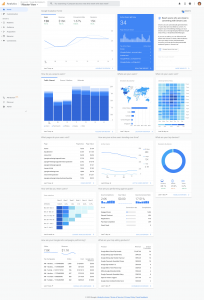
Mobile technology is at an all-time high and shows no signs of slowing down. End users couldn’t be more thrilled with their ability to ditch the bulky laptops and desktops in exchange for a savvy mobile device with identical capabilities. These capabilities include conducting business online with their favorite retailers and service providers.
But what happens when your website is not up to par? You either risk losing valuable clients or you make the decision to implement a responsive design model where content on the site are identical across the board.
Significance of Response Design
More than 46 percent of Internet searches are conducted via mobile devices, such as smartphones and tablets, according to The Sherwood Group.
So, it’s pertinent that your website be responsive so visitors are able to easily access,navigate and retrieve all the information they need at the tap of a finger. Responsive design creates a pleasurable viewing experience for both current and potential customers.
Benefits of Responsive Design
Do you really want your prospects spending time fiddling with screen settings if they can’t view your website from their mobile device? Of course not, and most of those who encounter issues of this sort will probably grow disgruntled with your mobile presence and take their business elsewhere.
User-Friendly
There was a time in the not-so-distant past when designing different mobile sites for different sized screens would have been a nightmare. But now, whether someone has a phone with a 5.5-inch screen, like the LG G3 or an 8-inch screen, like on the iPad mini, responsive design adapts. This enables end users to spend a bulk of their valuable time shopping, rather than troubleshooting.
Cost Efficient
Companies no longer have to dole out large wads of cash to have two distinct websites, one for desktop users and another for mobile users. Instead, a single responsive website will do the trick and also eliminate the need for separate SEO campaigns. End users, regardless of their choice of device are able to accomplish the same objective without resorting to a stationary device.
Boosts Competitive Advantage
Seem like you’re a step behind the competition? While it’s practically impossible to predict what their next move will be, you can convert your website to one that’s responsive and makes it convenient for your clients to conduct business online.
Preferred by Google
Since 67 percent of the search market belongs to Google, its opinion on responsive web design should not be taken lightly, reports The Huffington Post. In 2012, Pierre Far, Google Webmaster Trends Analyst, confirmed the search engine’s preference of responsive web design for mobile SEO.
Google’s stance on SEO, as paraphrased on Search Engine Land states:
“One URL makes it easier for your users to interact with the page and enable Google’s algorithms to assign the indexing properties to your content. It is also more efficient when Google is crawling your content because Google doesn’t have to crawl multiple pages.”
Increased Exposure
When branding your entity in an effort to boost exposure and convert prospects into clients or customers, you want to ensure your company is represented in the most professional manner possible. A responsive website supported on multiple mobile devices facilitates the consistent representation of your brand across all digital platforms and devices.
Digital & Social Articles on Business 2 Community
(228)








